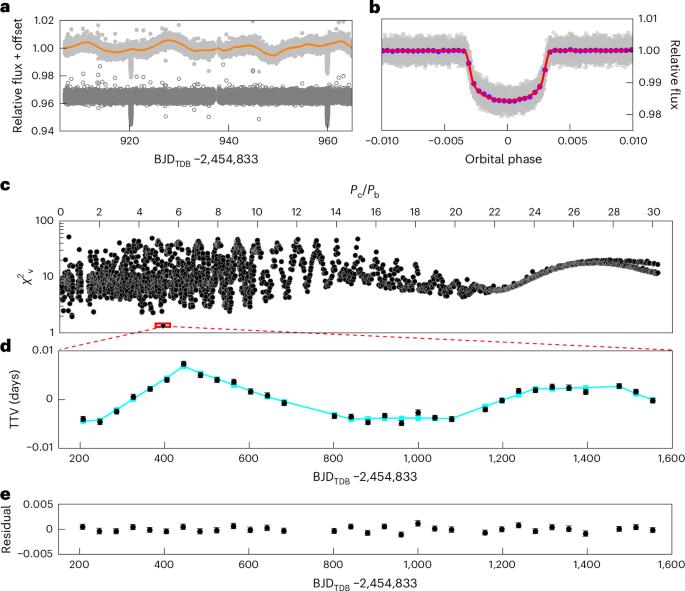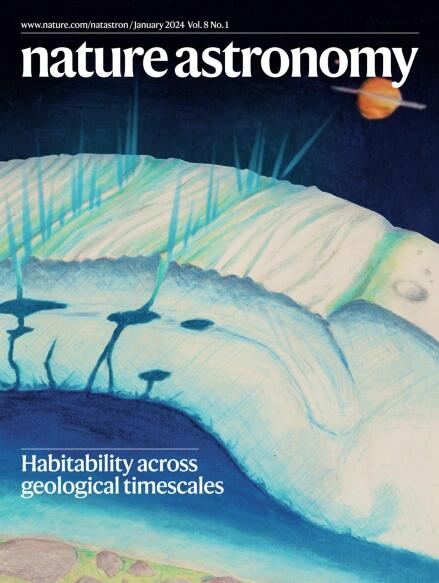A temperate 10-Earth-mass exoplanet around the Sun-like star Kepler-725
IF 14.3
1区 物理与天体物理
Q1 ASTRONOMY & ASTROPHYSICS
引用次数: 0
Abstract
The detection of low-mass exoplanets (≤10 Earth masses (M⊕)) yields fundamental inputs for current theories of planet formation and evolution, and supplies critical information for the planned direct-imaging missions that aim to detect and characterize Earth-like planets in the habitable zones around solar-like stars. However, the most efficient detection techniques available for low-mass exoplanets (that is, photometric transit and radial velocity methods) are heavily biased towards the detection of short-period planets (for example, ≤100 days) and strongly favour late-type stars. Here we report the discovery of Kepler-725 c, a 10 ± 3 M⊕ exoplanet within the habitable zone of the late G-type dwarf Kepler-725. Through analysis of the transit timing variations of the relatively short-period (39.64 days) warm Jupiter Kepler-725 b, we find that Kepler-725 c has a period of 207.5 days and travels in an eccentric orbit (with an eccentricity of 0.44 ± 0.02 and an orbital semi-major axis of 0.674 ± 0.002 au), receiving a time-averaged insolation of 1.4 times the Earth’s value. This discovery demonstrates that the transit timing variation method enables the detection and accurate mass measurement of a super-Earth/mini-Neptune within a solar-like star’s habitable zone. Similar searches for such exoplanets could be conducted in other exoplanetary systems in the era of the Transiting Exoplanet Survey Satellite mission and upcoming PLAnetary Transits and Oscillations of stars and Earth 2.0 missions. A 10-Earth-mass planet is detected in the habitable zone of the solar-type star Kepler-725 using the transit timing variation technique. This study proposes a complementary pathway to probe low-mass exoplanets (including Earth-like planets) in the habitable zones of Sun-like stars.


一颗温带的系外行星,质量为地球的10倍,围绕类太阳恒星开普勒-725运行
低质量系外行星(≤10个地球质量(M⊕))的探测为当前行星形成和演化理论提供了基础输入,并为计划中的直接成像任务提供了关键信息,该任务旨在探测和表征类太阳恒星周围可居住区内的类地行星。然而,对于低质量系外行星最有效的探测技术(即光度过境和径向速度方法)严重偏向于探测短周期行星(例如,≤100天),而强烈倾向于晚期恒星。在这里,我们报告了开普勒-725 c的发现,这是一颗10±3 M的系外行星,位于晚期g型矮星开普勒-725的可居住区内。通过对周期相对较短(39.64天)的暖木星Kepler-725 b凌日时间变化的分析,我们发现Kepler-725 c的周期为207.5天,运行在偏心轨道上(偏心率为0.44±0.02,轨道半长轴为0.674±0.002 au),时间平均日晒量为地球的1.4倍。这一发现表明,凌日时间变化方法能够在类太阳恒星的宜居带内探测和精确测量超级地球/迷你海王星的质量。在凌日系外行星调查卫星任务和即将到来的行星凌日和恒星与地球振荡2.0任务时代,可以在其他系外行星系统中进行类似的系外行星搜索。
本文章由计算机程序翻译,如有差异,请以英文原文为准。
求助全文
约1分钟内获得全文
求助全文
来源期刊

Nature Astronomy
Physics and Astronomy-Astronomy and Astrophysics
CiteScore
19.50
自引率
2.80%
发文量
252
期刊介绍:
Nature Astronomy, the oldest science, has played a significant role in the history of Nature. Throughout the years, pioneering discoveries such as the first quasar, exoplanet, and understanding of spiral nebulae have been reported in the journal. With the introduction of Nature Astronomy, the field now receives expanded coverage, welcoming research in astronomy, astrophysics, and planetary science. The primary objective is to encourage closer collaboration among researchers in these related areas.
Similar to other journals under the Nature brand, Nature Astronomy boasts a devoted team of professional editors, ensuring fairness and rigorous peer-review processes. The journal maintains high standards in copy-editing and production, ensuring timely publication and editorial independence.
In addition to original research, Nature Astronomy publishes a wide range of content, including Comments, Reviews, News and Views, Features, and Correspondence. This diverse collection covers various disciplines within astronomy and includes contributions from a diverse range of voices.
 求助内容:
求助内容: 应助结果提醒方式:
应助结果提醒方式:


